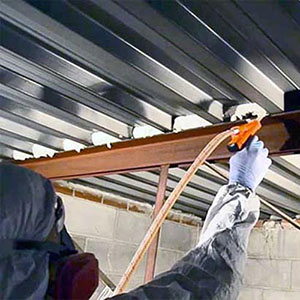If your new to spray foam and especially if your new to insulation in general you probably have a lot of questions about what all this industry lingo means. In this article we will go into the basics of our product and describe some of the most common terms and concepts behind spray foam insulation.
What is R-Value?
R-Value is a measure of how well an object resists the flow of heat. The greater the R-Value, the greater the heat resistance, and so the better the insulating properties of the object. Simply put, a styrofoam cooler has a higher R-Value than a paper bag. Keep in mind that R-Value works both ways. like a Thermos, and works to keep both heated and cooled air inside where you want it.
Insulation is rated in R-Value per inch, which represents how effective each inch of thickness is. The higher the insulation’s R-Value per inch, the more effective it is. Spray Foam enjoys some of the highest R-Values per inch in the industry.
What are Board Feet?
Board Feet are actually quite similar to square feet, but with thickness, or depth, thrown in. A board foot is 1 foot by 1 foot by 1 inch thick. So a 200 board foot kit would cover 200 square feet at 1 inch thick. It is vital to use board feet when calculating any Spray Foam project as multiple 1 inch layers can be used to provide a desired final R-Value for the project.
What Does 2-Component Mean?
Spray foam insulation kits come as two separate tanks. These contain the two main ingredients used to create the foam. (called isocyanate and polyol resin for you nerds out there). Just like a household epoxy, the two chemicals are inert until they are mixed to form the foam. Unlike household epoxy luckily there are no little mixing sticks involved. Once the hoses are connected the two tanks mix their contents automatically. As the ingredients enter the hose, the chemicals react, and the two liquids turn into spray foam.
The Two Main Types of Spray Foam
There are two main types of spray foam, and though they are similar, they have different properties and are intended for different end uses.
Open-Cell Foam
This type of foam uses a lot less material than closed-cell foam, but this gives it a lower R-Value (insulating ability). When applied, it expands to about 3 inches of thickness. The average R-Value of open-cell foam is about 3.5 to 3.6 per inch. This means a single application will yield an R-Value of 10-11. It is ideal for soundproofing and an economical choice for milder climates.
Closed-Cell Foam
This foam is much denser than open-cell foam. It has an R-Value of about 6.5 to nearly 7 per inch. The higher R-Value gives closed-cell spray foam higher thermal protection, making it the workhorse of the Spray Foam world. It expands to to 1 inch thick, and multiple applications can yield much higher R-Values. If keeping your space warm or cool in extreme temperatures is your goal, closed cell foam is the product you want.
See our in depth guide on these two types of foam to learn more.
How Much Does The Foam Expand?
The ability to expand is one of the key features and advantages that spray foam offers. Closed cell foam expands to approx. 1 inch thick when applied. Open cell foam expands to a whopping 3 inches thick. It’s this ability to expand that allows the foam to completely fill every crevasse and open space it encounters, providing a superior air seal that far outperforms other insulation types.
How Do I Estimate Spray Foam Insulation Cost?
In order to estimate a project you need two main numbers, the amount of surface area you need to cover (walls, ceilings, etc.) and the R-Value you wish to achieve. You can find a copy of the the U.S. Dept. of Energy’s suggested insulation ratings here. When figuring out how much foam you need you will have to use board feet and not just square feet. For example an 8’x20′ wall is 160 square feet, but to achieve an R-Value of 14 (2 inches of foam) would require 320 board feet. Remember a board foot is 1 square foot at 1 inch thick, and closed cell foam is R7 per inch. We have an online calculator available to help plan jobs, and our customer service reps are always happy to assist as well.
Is Spray Foam Insulation Safe?
Once the foam has cured it is essentially inert and much safer than fiberglass or cellulose, both of which can act as skin and respiratory irritants. The primary safety concerns with spray foam center on its application, where proper safety gear is an absolute must. Please see our full article, Safety First for in depth info on the safe application of our products.
Everything You Need to Know About Spray Foam
More in-depth info, how to videos and more are all available on tigerfoam.com and our customer service reps are always ready to help. Ready to install some spray foam insulation in your home? Give us a call and we’ll get you started down the path to energy savings!

